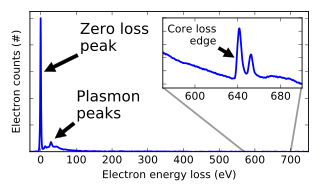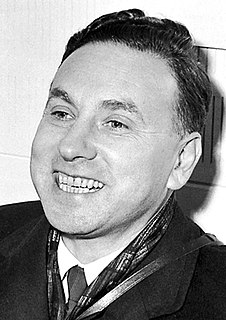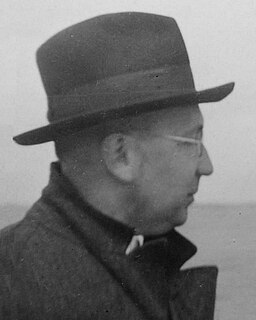Related Research Articles

Spectroscopy is the general field of study that measures and interprets the electromagnetic spectra that result from the interaction between electromagnetic radiation and matter as a function of the wavelength or frequency of the radiation. Matter waves and acoustic waves can also be considered forms of radiative energy, and recently gravitational waves have been associated with a spectral signature in the context of the Laser Interferometer Gravitational-Wave Observatory (LIGO)
Atomic, molecular, and optical physics (AMO) is the study of matter-matter and light-matter interactions; at the scale of one or a few atoms and energy scales around several electron volts. The three areas are closely interrelated. AMO theory includes classical, semi-classical and quantum treatments. Typically, the theory and applications of emission, absorption, scattering of electromagnetic radiation (light) from excited atoms and molecules, analysis of spectroscopy, generation of lasers and masers, and the optical properties of matter in general, fall into these categories.

Photoluminescence is light emission from any form of matter after the absorption of photons. It is one of many forms of luminescence and is initiated by photoexcitation, hence the prefix photo-. Following excitation, various relaxation processes typically occur in which other photons are re-radiated. Time periods between absorption and emission may vary: ranging from short femtosecond-regime for emission involving free-carrier plasma in inorganic semiconductors up to milliseconds for phosphoresence processes in molecular systems; and under special circumstances delay of emission may even span to minutes or hours.

In electron energy loss spectroscopy (EELS) a material is exposed to a beam of electrons with a known, narrow range of kinetic energies. Some of the electrons will undergo inelastic scattering, which means that they lose energy and have their paths slightly and randomly deflected. The amount of energy loss can be measured via an electron spectrometer and interpreted in terms of what caused the energy loss. Inelastic interactions include phonon excitations, inter- and intra-band transitions, plasmon excitations, inner shell ionizations, and Cherenkov radiation. The inner-shell ionizations are particularly useful for detecting the elemental components of a material. For example, one might find that a larger-than-expected number of electrons comes through the material with 285 eV less energy than they had when they entered the material. This is approximately the amount of energy needed to remove an inner-shell electron from a carbon atom, which can be taken as evidence that there is a significant amount of carbon present in the sample. With some care, and looking at a wide range of energy losses, one can determine the types of atoms, and the numbers of atoms of each type, being struck by the beam. The scattering angle can also be measured, giving information about the dispersion relation of whatever material excitation caused the inelastic scattering.

Robert Hofstadter was an American physicist. He was the joint winner of the 1961 Nobel Prize in Physics "for his pioneering studies of electron scattering in atomic nuclei and for his consequent discoveries concerning the structure of nucleons".

A synchrotron light source is a source of electromagnetic radiation (EM) usually produced by a storage ring, for scientific and technical purposes. First observed in synchrotrons, synchrotron light is now produced by storage rings and other specialized particle accelerators, typically accelerating electrons. Once the high-energy electron beam has been generated, it is directed into auxiliary components such as bending magnets and insertion devices in storage rings and free electron lasers. These supply the strong magnetic fields perpendicular to the beam which are needed to convert high energy electrons into photons.

X-ray absorption fine structure (XAFS) is a specific structure observed in X-ray absorption spectroscopy (XAS). By analyzing the XAFS, information can be acquired on the local structure and on the unoccupied local electronic states.

Extended X-ray absorption fine structure (EXAFS), along with X-ray absorption near edge structure (XANES), is a subset of X-ray absorption spectroscopy (XAS). Like other absorption spectroscopies, XAS techniques follow Beer's law. The X-ray absorption coefficient of a material as a function of energy is obtained using X-rays of a narrow energy resolution are directed at a sample and the incident and transmitted x-ray intensity is recorded as the incident x-ray energy is incremented.

X-ray absorption spectroscopy (XAS) is a widely used technique for determining the local geometric and/or electronic structure of matter. The experiment is usually performed at synchrotron radiation facilities, which provide intense and tunable X-ray beams. Samples can be in the gas phase, solutions, or solids.

Ralph Kronig was a German physicist. He is noted for the discovery of particle spin and for his theory of X-ray absorption spectroscopy. His theories include the Kronig–Penney model, the Coster–Kronig transition and the Kramers–Kronig relations.

Sir John Brian Pendry, is an English theoretical physicist known for his research into refractive indices and creation of the first practical "Invisibility Cloak". He is a professor of theoretical solid state physics at Imperial College London where he was head of the department of physics (1998–2001) and principal of the faculty of physical sciences (2001–2002). He is an honorary fellow of Downing College, Cambridge, and an IEEE fellow. He received the Kavli Prize in Nanoscience "for transformative contributions to the field of nano-optics that have broken long-held beliefs about the limitations of the resolution limits of optical microscopy and imaging.", together with Stefan Hell, and Thomas Ebbesen, in 2014.
X-ray absorption near edge structure (XANES), also known as near edge X-ray absorption fine structure (NEXAFS), is a type of absorption spectroscopy that indicates the features in the X-ray absorption spectra (XAS) of condensed matter due to the photoabsorption cross section for electronic transitions from an atomic core level to final states in the energy region of 50–100 eV above the selected atomic core level ionization energy, where the wavelength of the photoelectron is larger than the interatomic distance between the absorbing atom and its first neighbour atoms.

Walther Ludwig Julius Kossel was a German physicist known for his theory of the chemical bond, Sommerfeld–Kossel displacement law of atomic spectra, the Kossel-Stranski model for crystal growth, and the Kossel effect. Walther was the son of Albrecht Kossel who won the Nobel Prize in Physiology or Medicine in 1910.
David Locke Webster was an American physicist and physics professor, whose early research on X-rays and Parson's magneton influenced Arthur Compton.
The Korringa–Kohn–Rostoker (KKR) method is used to calculate the electronic band structure of periodic solids. In the derivation of the method using multiple scattering theory by Jan Korringa and the derivation based on the Kohn and Rostoker variational method, the muffin-tin approximation was used. Later calculations are done with full potentials having no shape restrictions.
X-ray Raman scattering (XRS) is non-resonant inelastic scattering of X-rays from core electrons. It is analogous to vibrational Raman scattering, which is a widely used tool in optical spectroscopy, with the difference being that the wavelengths of the exciting photons fall in the X-ray regime and the corresponding excitations are from deep core electrons.
FEFF is a software program used in x-ray absorption spectroscopy. It contains self-consistent real space multiple-scattering code for simultaneous calculations of x-ray-absorption spectra and electronic structure. Output includes extended x-ray-absorption fine structure (EXAFS), full multiple scattering calculations of various x-ray absorption spectra (XAS) and projected local densities of states (LDOS). The spectra include x-ray absorption near edge structure (XANES), x-ray natural circular dichroism (XNCD), and non-resonant x-ray emission spectra. Calculations of the x-ray scattering amplitude and spin dependent calculations of x-ray magnetic circular dichroism (XMCD) and spin polarized x-ray absorption spectra are also possible, but less automated.

Modern spectroscopy in the Western world started in the 17th century. New designs in optics, specifically prisms, enabled systematic observations of the solar spectrum. Isaac Newton first applied the word spectrum to describe the rainbow of colors that combine to form white light. During the early 1800s, Joseph von Fraunhofer conducted experiments with dispersive spectrometers that enabled spectroscopy to become a more precise and quantitative scientific technique. Since then, spectroscopy has played and continues to play a significant role in chemistry, physics and astronomy. Fraunhofer observed and measured dark lines in the Sun's spectrum, which now bear his name although several of them were observed earlier by Wollaston.

Elias Burstein was an American experimental condensed matter physicist whose active career in science spanned seven decades. He is known for his pioneering fundamental research in the optical physics of solids; for writing and editing hundreds of articles and other publications; for bringing together scientists from around the world in international meetings, conferences, and symposia; and for training and mentoring dozens of younger physicists.
Linda Young is a distinguished fellow at the U.S. Department of Energy’s (DOE) Argonne National Laboratory and a professor at the University of Chicago’s Department of Physics and James Franck Institute. Young is also the former director of Argonne’s X-ray Science Division.
References
- ↑ "APSUO Arthur H. Compton Award - Past Winners | Advanced Photon Source".
- ↑ "IXAS Awards – IXAS: The International X-ray Absorption Society".
- ↑ "Archived copy". Archived from the original on 2004-01-29. Retrieved 2014-01-01.
{{cite web}}: CS1 maint: archived copy as title (link) - ↑ J. J. Rehr; R. C. Albers (2000). "Theoretical Approaches to X-ray Absorption Fine Structure". Reviews of Modern Physics . 72 (3): 621–654. Bibcode:2000RvMP...72..621R. doi:10.1103/revmodphys.72.621.
- ↑ J. J. Rehr; A. L. Ankudinov (2001). "New Developments in the Theory of X-ray Absorption and Core Photoemission". J. Electron Spectros. Relat. Phenomena . 114: 1115–1121. doi:10.1016/S0368-2048(00)00341-8.
- ↑ ETSF
- ↑ "John J. Rehr".
- ↑ J. J. Rehr (2003). "Excited State Electronic Structure and the Theory of X-ray Spectra". J. Phys.: Condens. Matter . 15 (5): S647–S654. Bibcode:2003JPCM...15S.647R. doi:10.1088/0953-8984/15/5/317. S2CID 250803201.
- ↑ "John J. Rehr | Energy Research at the University of Washington". www.washington.edu. Archived from the original on 2011-02-20.
- ↑ J. Mustre de Leon; Y. Yacoby; E.A. Stern; J.J. Rehr (1990). "The Analysis of Experimental EXAFS Data Using Calculated Curved Wave Multiple Scattering EXAFS Spectra". Phys. Rev. B . 42 (17): 10843–10851. doi:10.1103/physrevb.42.10843. PMID 9995359.
- ↑ J. J. Rehr; A. Ankudinov; S. I. Zabinsky (1998). "New Developments in NEXAFS/EXAFS Theory". Catalysis Today . 39 (4): 263–269. doi:10.1016/s0920-5861(97)00109-0.
- ↑ FEFF
- ↑ "ESRF EXAFS Software Catalog: Feff".
- ↑ "- YouTube". YouTube .
- ↑ CMCSN
- ↑ "APSUO Arthur H. Compton Award - Past Winners | Advanced Photon Source".
- ↑ "IXAS Awards – IXAS: The International X-ray Absorption Society".
- ↑ "APS Fellow Archive".